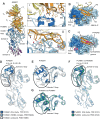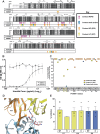Potent AMA1-specific human monoclonal antibody against Plasmodium vivax Pre-erythrocytic and Blood Stages
- PMID: 39632799
- PMCID: PMC11618605
- DOI: 10.1038/s41467-024-53848-4
Potent AMA1-specific human monoclonal antibody against Plasmodium vivax Pre-erythrocytic and Blood Stages
Abstract
New therapeutics are necessary for preventing Plasmodium vivax malaria due to easy transmissibility and dormancy in the liver that increases the clinical burden due to recurrent relapse. In this manuscript we characterize 12 Pv Apical Membrane Antigen 1 (PvAMA1) specific human monoclonal antibodies from Peripheral Blood Mononuclear Cells of a Pv-exposed individual. PvAMA1 is essential for sporozoite and merozoite invasion, making it a unique therapeutic target. We show that humAb 826827 blocks the invasion of human reticulocytes using Pv clinical isolates and inhibits sporozoite invasion of human hepatocytes in vitro (IC50 of 0.3 - 3.7 µg/mL). Inoculation of human liver transgenic (FRG-humHep) female mice with humAb 826827 significantly reduces liver infection in vivo. The crystal structure of rPvAMA1 bound to 826827 shows that 826827 partially occupies the highly conserved hydrophobic groove in PvAMA1 that binds its known receptor, RON2. We have isolated a potent humAb that is isolate-transcendent, blocks both pre-erythrocytic and blood stage infection, and could be a potential therapy for Pv.
© 2024. This is a U.S. Government work and not under copyright protection in the US; foreign copyright protection may apply.
Conflict of interest statement
Competing interests: The authors declare no competing interests.
Figures






Update of
-
Potent AMA1-specific human monoclonal antibody against P. vivax Pre-erythrocytic and Blood Stages.bioRxiv [Preprint]. 2024 Aug 17:2024.02.07.579302. doi: 10.1101/2024.02.07.579302. bioRxiv. 2024. Update in: Nat Commun. 2024 Dec 4;15(1):10556. doi: 10.1038/s41467-024-53848-4. PMID: 38370683 Free PMC article. Updated. Preprint.
References
Publication types
MeSH terms
Substances
Associated data
- Actions
Grants and funding
LinkOut - more resources
Full Text Sources

